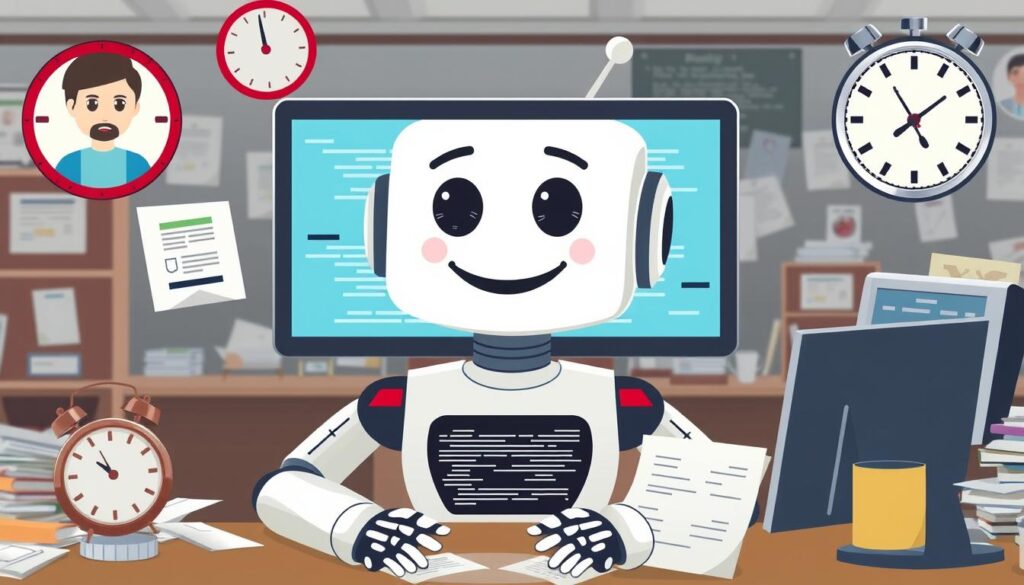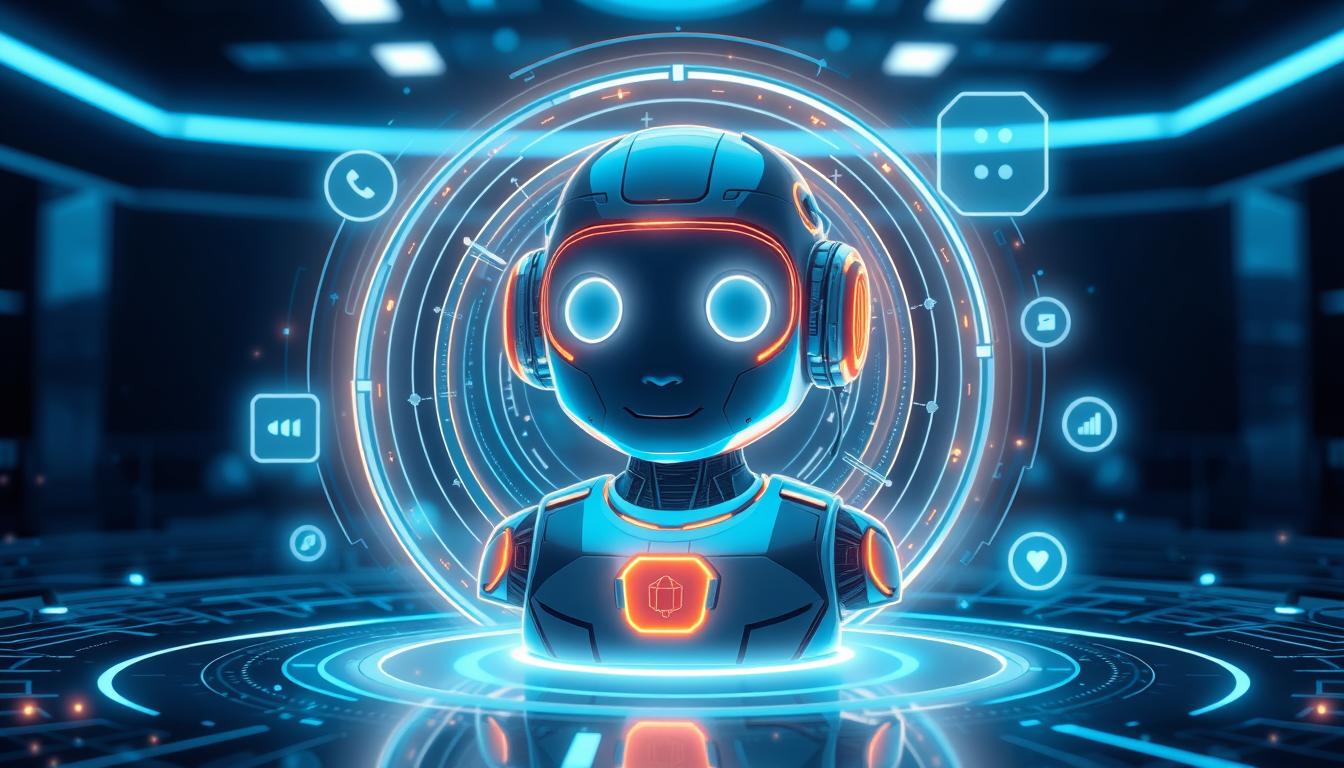“As an Amazon Associate I earn from qualifying purchases.” .
Have you ever felt frustrated waiting on hold for customer service? I have too. That’s why I’m excited about chatbots. These AI-powered virtual assistants change how businesses talk to customers, giving instant help anytime.
Chatbots are changing customer support. They’re not just simple automated systems. They’re advanced AI tools that can tackle complex questions. They can talk to many customers at once, helping businesses serve more without adding staff.
Chatbots have a big impact on customer service. Did you know 62% of people like using chatbots over waiting for a human? This is making the chatbot industry grow fast. It’s expected to hit $1.25 billion by 2025, up from $190.8 million in 2016.
Chatbots are big in retail and hospitality. In retail, 21.50% of AI chatbot use is for managing customer relationships. The hospitality sector saw a 53% jump in chatbot use in 2022. This improved booking and gave guests help right away.
Key Takeaways
- Chatbots offer 24/7 instant customer support
- 62% of consumers prefer chatbots over human agents
- The chatbot industry is projected to reach $1.25 billion by 2025
- Chatbots can handle multiple conversations simultaneously
- AI-powered chatbots can resolve over 80% of customer issues independently
- Chatbots are widely adopted in retail and hospitality industries
What are Chatbots and How Do They Work?
Chatbots are changing customer support by talking to clients through AI. They use natural language to understand and answer questions. This means they can help customers anytime, day or night.
Definition of Chatbots
Chatbots are AI tools that seem to talk like humans. They figure out what you mean and give you the right info. This makes customer support faster and easier. The chatbot market is growing fast, expected to hit $102 billion by 2028.
Basic Functionality
Chatbots work by recognizing how we speak and what we mean. They use natural language to answer questions. This lets them handle lots of customer queries quickly.
Types of Chatbots
There are two main kinds of chatbots:
- Rule-based chatbots: These follow set rules and paths. They’re cheaper and simpler to set up but aren’t as flexible.
- AI-powered chatbots: These use learning and natural language to act like humans. They get better with each chat, giving more personalized help.
Both kinds are important for customer support today. AI chatbots are becoming more popular because they can handle tough questions and offer tailored help.
The Benefits of Using Chatbots in Customer Support
Chatbots are changing the game in customer service. They offer many benefits for both businesses and customers. These AI helpers are making it easier for companies to talk to their clients quickly and efficiently, day and night.
Improved Response Times
Chatbots are super fast at answering questions. They can talk to many people at once, which means no long waits. In fact, they can answer simple questions up to 80% faster than a human.
Most customers expect a chatbot to respond in just 5 seconds. This quick service is a big plus.
Enhanced Customer Experience
Chatbots make customer service better by being available all the time. This is something 64% of customers really like. They also get to know each customer better, making their responses more personal.
Chatbots can solve most problems on their own, about 70% of the time. This has made them more popular, with 67% of people using them in the last year. And 65% of users prefer to deal with chatbots instead of humans.
| Chatbot Benefit | Impact |
|---|---|
| Cost Savings | Up to 30% reduction in customer support costs |
| Efficiency | Can handle up to 79% of routine questions |
| Customer Preference | 55% choose chatbots over waiting for live agents |
The advantages of AI bots in customer service go beyond just being fast. They can also save businesses a lot of money, up to 30%. This, along with their ability to offer personalized service, makes chatbots a key part of modern customer support.
Key Features of Effective Chatbots
Effective chatbots are changing customer support with new features. These AI tools use the latest tech for smooth talks and insights for businesses.
Natural Language Processing
Natural Language Processing (NLP) is key for chatbots today. It lets chatbots understand human language, like what we mean and what we’re talking about. This tech helps chatbots have real conversations.
Integration with Other Tools
Chatbots that work well with other tools are more useful. They connect with CRM systems and e-commerce sites to offer better service. This makes customer support smoother and more effective.
User-Friendly Interface
A chatbot’s design matters a lot. It should be easy for everyone to use. Good design makes talking to chatbots a breeze, making customers happier.
| Feature | Benefit |
|---|---|
| Sentiment Analysis | Adapts responses based on customer emotions |
| Omnichannel Support | 91% greater year-over-year customer retention |
| Analytics | Provides insights into customer journey and KPIs |
Chatbots are now vital for businesses wanting better customer support. As tech gets better, chatbots will get closer to real human talks.
Common Types of Chatbots for Businesses
Chatbots are key for businesses today, with many types to meet various needs. They help with customer support and make operations smoother.
Rule-Based Chatbots
Rule-based chatbots follow set rules. They’re great for simple questions and quick answers. They’re easy to start and need little training, perfect for quick setup.

AI-Powered Chatbots
AI-powered chatbots use machine learning and natural language to understand users. They can tackle complex issues and learn from interactions. They get better over time through learning from past chats.
| Chatbot Type | Key Features | Business Benefits |
|---|---|---|
| Rule-Based | Predefined rules, Quick setup | Efficient for simple queries |
| AI-Powered | NLP, Machine learning | Adaptive, Handles complex issues |
| Hybrid | Combines rule-based and AI | Versatile, Balanced approach |
Businesses can pick the best chatbot for their needs. The global chatbot market is expected to hit $9.4 billion. This shows how important AI tools are in today’s business world.
How Chatbots Enhance Customer Engagement
Chatbots change the game in customer service by being available 24/7 and giving personalized help. These AI helpers make it easier for businesses to talk to their customers. This leads to happier customers and more loyalty.
24/7 Availability
Chatbots are always ready to help, no matter the time. They can talk to many people at once, cutting down wait times. This means customers get help right away, making them happier and more engaged.
Personalized Interactions
Chatbots use data to give each customer a unique experience. They remember what you’ve talked about before, making their answers feel more like from a real person. This makes customers feel valued and builds stronger relationships.
Data-Driven Insights
Chatbots gather important info on what customers like and don’t like. This helps businesses make their products better and improve the customer experience. The data chatbots collect helps businesses make smart choices and keep getting better.
“Chatbots respond to customer queries three times faster than humans and complete over 30% of staff-performed tasks.”
Chatbots have a big impact on how businesses talk to their customers. With a market value expected to hit $15.5 billion by 2028, they’re becoming key for businesses wanting to boost their customer service.
Integration of Chatbots into Your Business
Adding chatbots to your business can make customer support better and operations smoother. It’s important to pick the right chatbot platforms and strategies for successful integration.
Choosing the Right Platform
When picking a chatbot platform, think about what you need and what you already use. Look for platforms that are easy to customize and work well with your tools. They should also grow with your business.
AI chatbots are becoming more popular. They are expected to be used more than rule-based chatbots by 2024.
Deployment Strategies
Good deployment strategies start small. Begin with simple tasks and add more as you go. This makes it easier for your business to adjust and for your team to learn new things.
Make sure your support staff is well-trained. Also, have clear steps for when a human needs to step in.
It’s key to connect chatbots with your CRM and other tools. This can lead to great results:
- Reduce handling time by up to 80%
- Increase revenue by an average of 67%
- Automate up to 70% of customer queries
- Improve customer satisfaction scores by 20%
By focusing on these areas, businesses can use chatbots to their fullest. This improves customer service and makes operations more efficient. As chatbot tech gets better, staying up-to-date is key to staying ahead in customer support.
Best Practices for Implementing Chatbots
Getting chatbots to work well needs a smart plan. It’s all about what customers want and making things better over time. By doing this, companies can get the most out of chatbots and improve how they help customers.
Understanding Customer Needs
Knowing what customers need is key to a good chatbot. Look at what customers say and do to find out what they often ask or struggle with. This helps make chatbots that really help with these issues.
Improving chatbots depends a lot on what customers say. A study by Intercom showed that using chatbots can make customers spend 67% more. This shows how important it is to make chatbot talks match what users want.
Continuous Learning and Improvement
Keeping chatbots smart is essential. Keep their knowledge up to date with new info and answers to common questions. Watch how they do and use AI to make them better at talking to users.
| Chatbot Implementation Best Practices | Benefits |
|---|---|
| 24/7 Availability | 51% of clients expect businesses to be available at all times |
| Self-Service Options | Improves perception for 77% of users |
| Personalized Interactions | Increases customer satisfaction and loyalty |
| Data Collection | Gathers valuable insights on customer preferences and behavior |
It’s important to mix automated chat with human help. Make sure users can easily talk to real people when needed. This way, businesses can really use chatbots to help customers.
Challenges of Using Chatbots in Customer Service
Chatbots have changed customer support, but they have their limits. As companies use AI, they face special challenges. These need careful handling.
Overcoming Miscommunication
Miscommunication is a big problem with chatbots. They might not get complex questions or understand language well. Only 20% of people trust bots for help.

Businesses must improve chatbots’ language skills and keep their knowledge up to date. This is key to making AI support better.
Balancing Automation and Human Interaction
Finding the right mix of chatbots and human help is key. Chatbots are good for simple questions, but complex ones need a person. 54% of people prefer talking to a real person, even if it takes longer.
| Aspect | Chatbot | Human Agent |
|---|---|---|
| Availability | 24/7 | Limited hours |
| Query Complexity | Simple to moderate | Complex |
| Empathy | Limited | High |
| Cost-effectiveness | High | Moderate |
To solve these problems, companies should have clear plans for when to use chatbots and when to call a human. This way, they can keep customers happy while using AI.
The Future of Chatbots in Customer Support
The future of customer service is changing fast with new AI trends. Chatbots are set to change how businesses talk to their customers. As AI gets better, we’ll see big changes in how we get help.
Advances in AI Technology
AI chatbots are getting smarter. They now understand what we mean better thanks to natural language processing. This lets them deal with tough questions easily. By 2027, the chatbot market is expected to hit $3.99 billion, growing fast.
Predictions for Customer Interaction
Voice-activated chatbots are becoming more popular. In 2022, 125.2 million people in the US used voice assistants. These tools will likely be used more in customer support, making things easier for users.
Using chatbots can save businesses up to 30% on customer service costs. This is why more companies are using them. In fact, 69% of people prefer chatbots for fast answers. As AI gets better, chatbots will give more tailored and proactive help.
“AI chatbots are not just a trend, they’re the future of customer service. They’re set to transform how businesses interact with their customers, providing personalized, efficient, and round-the-clock support.”
The future of customer service is about seamless experiences across all channels. Chatbots will work with new tech like augmented reality and Internet of Things devices. This will make support more immersive and efficient, setting new standards.
Case Studies: Successful Chatbot Implementations
Leading brands share their chatbot success stories. These examples show how AI can change customer support.
Examples from Leading Brands
Microsoft’s XiaoIce chatbot started in 2014 and quickly became a hit. It had 0.5 billion conversations in just three months. People talked to it for an average of 23 times, more than usual human chats.
Casper’s Insomnobot-3000 talks to people late at night. It helps those who can’t sleep, showing chatbots can help in special ways.
Lessons Learned
Looking at these success stories, we learn important lessons. LambdaTest used Zoho SalesIQ and saw a big boost in efficiency. This shows picking the right chatbot is key.
| Chatbot | Industry | Key Achievement |
|---|---|---|
| XiaoIce | General Conversation | 0.5 billion conversations in 3 months |
| Insomnobot-3000 | Health & Wellness | Targeted engagement for insomniacs |
| Zoho SalesIQ | Customer Support | 40% increase in operator efficiency |
These stories teach us to always improve and work well with other systems. They remind us to balance chatbots with human touch. By following these tips, businesses can make their customers happier and work more efficiently.
Measuring the Effectiveness of Your Chatbot
It’s key to track how well your chatbot works to improve customer support. Good chatbot analytics show if you’re doing well and where you can get better. We’ll look at important performance metrics and ways to get feedback from customers.
Key Performance Indicators
Performance metrics give us useful info on how our chatbot does. Important ones are how fast it responds, how long chats last, and how often it meets its goals. These help us see if users are happy and engaged.
| Metric | Formula | Importance |
|---|---|---|
| Average Chat Duration | Total chat durations ÷ Total sessions | Measures efficiency |
| Goal Completion Rate | (Goals completed ÷ Total sessions) x 100 | Indicates success rate |
| Human Takeover Rate | (Escalated conversations ÷ Total conversations) x 100 | Shows AI limitations |
Customer Feedback Methods
It’s important to know how customers feel about your chatbot. Use surveys after chats to get their thoughts. Also, check how people feel about your chatbot on social media.
Chatbot analytics dashboards give us quick info on how our chatbot is doing. They help us see how users interact, find common problems, and make our chatbot better. Checking these regularly helps us keep improving and meet our goals.
“82% of people prefer using a chatbot for help instead of waiting for a human.” – Tidio Survey
By using chatbot analytics and listening to customers, we can make our AI support better. This way, we can give our customers a better experience and work more efficiently.
Resources for Learning More About Chatbots
The chatbot world is expanding quickly. In fact, chatbots can increase weekly sales by 7.67 times for online stores. To stay ahead, you need the best chatbot learning resources. Let’s look at some top choices for AI education and customer service training.
Online Courses and Certifications
Many online platforms have courses on chatbot development. They cover AI basics, natural language processing, and building chatbots. Some even teach using tools like IBM’s Watson Assistant. This tool lets non-coders make AI chatbots in under 30 minutes.
Books and Industry Publications
Books offer deep insights into chatbot design. Websites like ChatbotMagazine.com share the latest trends. They’re great for keeping up with chatbot technology. Remember, 94% of people find chatbot info helpful, so these resources are worth your time.
Whether you pick online courses or books, keep learning. Chatbots are changing fast. With Watson Assistant’s free Lite plan, you can practice building chatbots. This hands-on experience is key to mastering chatbot creation and improving your customer service skills.
FAQ
What are chatbots?
How do chatbots work?
What are the main types of chatbots?
What are the benefits of using chatbots in customer support?
What features should an effective chatbot have?
How do chatbots enhance customer engagement?
How can businesses integrate chatbots effectively?
What are the challenges of using chatbots in customer service?
What does the future hold for chatbots in customer support?
How can businesses measure the effectiveness of their chatbots?
“As an Amazon Associate I earn from qualifying purchases.” .



